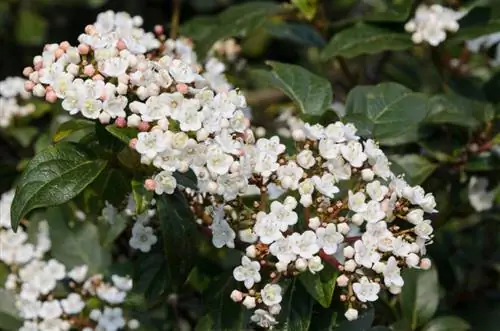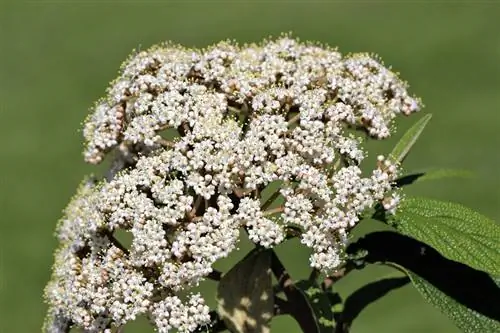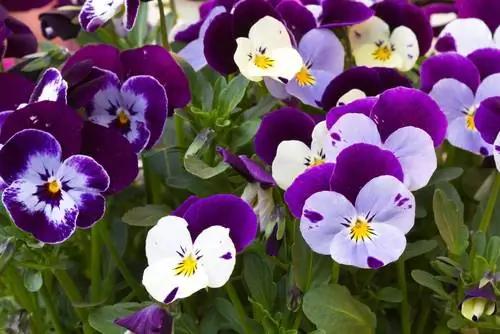- Author admin [email protected].
- Public 2023-12-25 17:45.
- Last modified 2025-01-23 11:22.
The evergreen snowball rounds off its exotic, opulent appearance with undemanding frugality. In order for the shiny green foliage, the lavish winter blossoms and the dark blue fruit to develop to their perfection, only a few care measures are required. The following answers to frequently asked questions get to the heart of all the relevant details.

What are the care requirements of Viburnum Tinus?
The Viburnum Tinus, also known as the evergreen viburnum, is an undemanding ornamental shrub that offers shiny, green leaves, winter flowers and blue fruit decorations. It prefers a sunny, protected location in humus-rich, nutrient-rich soil and requires moderate irrigation and fertilization.
Planting Viburnum tinus correctly
In the open ground, plant a Mediterranean viburnum in a sunny, warm and protected location. Choose a mild day between mid and late May to thoroughly loosen up the humus-rich, nutrient-rich soil. The planting pit is about twice as large as the root ball. Add compost (€12.00 on Amazon), horn shavings and a little sand to the excavation. Position the potted young plant in the planting hole in such a way that the root ball ends up flush with the surface. After the pit has been filled with the enriched substrate, press the soil and water. A mulch layer of leaves, grass clippings or bark mulch keeps the soil warm and moist for longer.
Care tips
An evergreen snowball owes its popularity not least to the following, uncomplicated care program:
- Keep the soil constantly slightly moist all year round with occasional drying out
- Fertilize outdoor shrubs with compost in March/April and June/July
- Administer a liquid fertilizer every 14 days in the bucket from March to September
- Light topiary if necessary immediately after flowering, including thorough thinning
Without careful winter protection, an evergreen snowball rarely makes it through the cold season unscathed. Put a breathable fleece hood over the ornamental tree and cover the substrate with leaves, straw or needle twigs. You also wrap the bucket with foil and push a block of wood under it.read more
Which location is suitable?
Evergreen snowball delights us with its high location tolerance. The Mediterranean ornamental tree thrives excellently in full sun to partial shade. A warm, protected location in a mild wine-growing climate is advantageous, whereby the shrub benefits from its extreme heat tolerance. In well-drained soil, humus and moderately dry to freshly moist, a Viburnum tinus likes to spread its roots.read more
What soil does the plant need?
In the open field, an evergreen viburnum prefers fresh, nutrient-rich and humus-rich soil. A sandy-loamy soil with first-class drainage meets the requirements perfectly. For cultivation in a bucket, we recommend a high-quality, structurally stable, compost-based substrate. When purchasing products rich in peat, ignore them as they are not suitable for long-term care of the slow-growing Mediterranean viburnum.
What is the best time to plant?
A snowball grown in a container can be planted in the pot at any time of the year. For cultivation outdoors, we recommend spring as the optimal planting time. If frosty nights are no longer to be expected from the beginning/mid of May, the Mediterranean viburnum will find the best conditions to take root until winter.
When is flowering time?
The type of cultivation largely determines the flowering period. If an evergreen viburnum thrives in the protected ambience of the winter garden, it puts on its magnificent flower dress between November and February. If the ornamental tree is displayed in the garden or on the balcony, the numerous buds open - depending on the weather conditions - between January and April.read more
Cut Viburnum tinus correctly
The round, compact crown is naturally created by an evergreen viburnum. The gardener's job is simply to maintain shape and thin out regularly. How to do it right:
- Put on gloves to avoid skin contact with the poisonous plant sap
- Short shoots that are too long immediately after flowering
- Place the scissors just above an outward-facing leaf node
- Cut off dead branches at the base
Give a Mediterranean viburnum 2 to 3 years to develop its natural silhouette before cutting for the first time. Due to its slow growth, topiary is only necessary every few years. Individual, nose-like shoots can be cut off at any time. Thorough thinning after the flowering period, on the other hand, is part of the care program every year.read more
Watering Viburnum tinus
In the best case, the water balance is based on a slightly moist substrate with the surface drying out in the meantime. Water a bay leaf viburnum only when the soil feels dry in the top 1-2 cm. Avoid the formation of waterlogging, as the ornamental tree will react to this with root rot.
Fertilize Viburnum tinus properly
An evergreen snowball outdoors receives an organic fertilizer, such as compost, bark humus, horn shavings or guano granules, in March/April and June/July. In pot cultivation, we recommend applying liquid fertilizer for flowering bushes every 2 weeks from March to September.
Wintering
In mild, sheltered locations, an evergreen snowball will survive the cold season he althy with winter protection. This applies both to the field and to the container. With these precautions you will do it right:
- Put a breathable fleece over the ornamental shrub before the first frost
- Cover the soil and substrate thickly with leaves and sticks
- Place additional buckets on wood or Styrofoam in front of the south wall of the house
Where space allows, move the planter to a bright winter quarter with temperatures of 5 to 8 degrees Celsius. Please remember that the ornamental shrub continues to evaporate moisture. Water the bed and pot every now and then so that the soil or substrate has a minimum moisture content.
Propagate Viburnum tinus
If an evergreen viburnum is full of sap, cut half-woody, non-flowering head cuttings 10-15 cm long. If the lower part is stripped of leaves and planted in pots with lean substrate, the shoots root quickly. Care for the cuttings in a partially shaded, warm window seat until next spring. Once a vital root system has developed, repot your plants in normal substrate enriched with a little sand or lava granules. In May, plant the young plants outdoors in a sunny, warm location in permeable, nutrient-rich soil.
Is Viburnum tinus poisonous?
An evergreen snowball is moderately poisonous in all parts and is therefore unfortunately not suitable for cultivation in the family garden. The blue-black berries are too tempting to be tasted by curious children. Intentional and unintentional consumption causes typical symptoms of poisoning in humans and animals, such as nausea, vomiting and cramps.read more
Beautiful varieties
- Eva Price: Compact dwarf shrub, blooming profusely in delicate white-pink; ideal for keeping in containers; 100-200cm
- Purpurea: The variety impresses with green, purple leaves and pink-white flower umbels; 150-200cm
- French White: Vigorous evergreen viburnum with pure white flowers in late winter; 150-200cm
- Exbury Form: Premium variety with fragrant flowers, shiny leaves and dark fruit decorations; 250-300cm
- Variegatum: Variegated, evergreen viburnum with pink buds, white flowers and blue berries; 200-250cm






